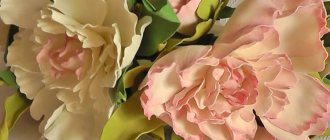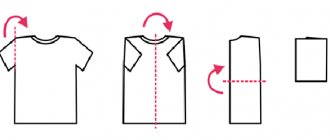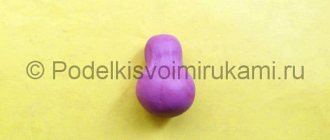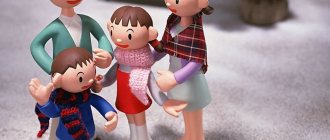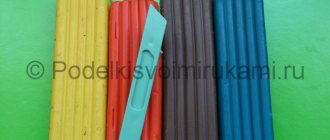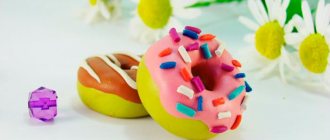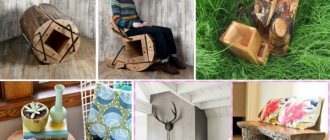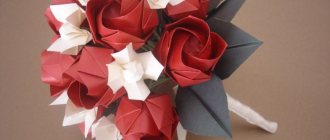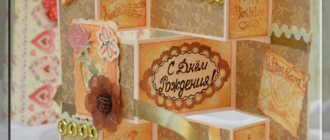Plasticine is considered an excellent material not only for the embodiment of creative ideas, but also for the development of motor skills of the hands and fingers, which will help children quickly master writing techniques. But not only small children, but also many adults sculpt from plasticine. Softening the plastic mass made from powdered clay, wax, and petroleum jelly with your hands calms the nervous system, and the creative ideas embodied in the works will delight and improve your mood.
A child, working with plasticine, learns orientation in space and learns the shape and components of objects, acquires the necessary knowledge about the properties of the material and its features. For example, if you make “Flowers” from plasticine, children will learn to distinguish them by appearance. They will also remember the shape of the petals, parts of the plant, and understand how many varieties of flowers there are on Earth.
In this article we will look at how to make a flower from plasticine with your own hands: both on cardboard and in volume. After reading the detailed instructions, you can create a beautiful craft yourself for an exhibition at school.
Volumetric flower
For this work you will need pink and white plasticine. First the petals are molded. As with all modeling work, the material is first softened by kneading in the hand. Then you need to divide the plasticine into several parts, according to the number of future petals. Each piece is transformed into a round and smooth ball by rolling. Then use your hand to flatten it a little into a flat oval.
One side of the resulting workpiece is flattened in half by pressing with fingers on both sides. This is how they work on all elements. When the required number of petals is made, attach them to each other in the middle. To avoid visible joints between the parts, you also need to sculpt the middle of the flower. To do this, roll out a ball from white plasticine and flatten it into a circle with your fingers. Attach it to the center of the craft. You can use the point of a knitting needle or a pencil to make dents or dots.
You already know how to make a flower from plasticine. Now let’s imagine what kind of picture on cardboard can be made from these few flowers. One option is to make a bouquet and place it in a vase. Another is to make grass out of green sticks and plant flowers vertically along the width of the leaf. There will be a simple lawn. On top we will add a sun with rays and a bee. The result will be a beautiful landscape.
Plastids
Plastids (from the ancient Greek Πλαστόс - fashioned) are semi-autonomous organelles of higher plants, algae and some photosynthetic protozoa. Plastids have from two to four membranes, their own genome and a protein synthesizing apparatus.
According to the symbiogenetic theory, plastids, like mitochondria, arose as a result of the “capture” of an ancient cyanobacterium by the predecessor of a eukaryotic “host” cell. In this case, the outer membrane of the plastids corresponds to the plasma membrane of the host cell, the intermembrane space corresponds to the external environment, the internal membrane of the plastids corresponds to the membrane of the cyanobacterium, and the stroma of the plastids corresponds to the cytoplasm of the cyanobacterium. The presence of three (euglena and dinoflagellates) or four (golden, brown, yellow-green, diatoms) membranes is considered the result of two- and three-fold endosymbiosis, respectively.
Chloroplasts (from the Greek Χλωρός - “green”) are green plastids that are found in the cells of photosynthetic eukaryotes. With their help, photosynthesis occurs. Chloroplasts contain chlorophyll.
One leaf cell can contain 15-20 or more chloroplasts, and some algae have only 1-2 giant chloroplasts (chromatophores) of various shapes.
Chloroplasts are bounded by two membranes - outer and inner. The outer membrane delimits the liquid internal homogeneous environment of the chloroplast - the stroma (matrix). The stroma contains proteins, lipids, DNA (circular molecule), RNA, ribosomes and storage substances (lipids, starch and protein grains), as well as enzymes involved in the fixation of carbon dioxide .
The inner membrane of the chloroplast forms invaginations into the stroma - thylakoids, which have the shape of flattened sacs (cisterns). Several of these thylakoids lying on top of each other form a grana, in which case they are called grana thylakoids. It is in the thylakoid membranes that light-sensitive pigments are localized, as well as electron and proton carriers that participate in the absorption and transformation of light energy.
Figure 10. Chloroplasts.
Plasticine flowers on cardboard
This sculpting method is significantly different from the previous sample. Here, the outlines of a flower are laid out on cardboard made from thin sticks of plasticine, and then these voids are filled with small balls from plasticine of the required color.
For the petals, you can take several shades of the same color. In your work, you must use only balls of the same size. This plasticine flower looks like a mosaic picture.
How to make a rose from plasticine?
The photograph in the article shows that this process is, in principle, simple. Depending on the size of the flower, the required number of petals is prepared. A large piece of plasticine is divided into several equal pieces. First, roll each into a ball, then place it on a modeling board and flatten it with your fingers, giving it the shape of a circle. When the blanks are ready, they are laid out overlapping along a horizontal line, as in the photo below.
Then, carefully, holding the lower part of the flower with your fingers, roll the circles into a roll. The upper edges of each petal bend slightly outward. And the lower part is fastened together and smoothed to a smooth surface. Then you can put the flower on a stick and cover it with green plasticine.
Leaves are cut out of green plasticine rolled out with a rolling pin using a stack. It also draws the veins of the leaf.
Subtleties of manufacturing
The choice of cage dimensions for songbirds directly depends on their size. For miniature birds, a small structure made of plastic or metal is suitable. It is best to choose a rectangular shape. The perches in such a cage are located at different heights, which will help its inhabitant move from top to bottom with ease. In this case, the drinking bowl and container with grain are placed on the floor of the “dwelling.” It is better to make the tray retractable to make it easier to keep the cage clean.
Round designs are no less popular. Large vintage checks look very impressive. Such a house for birds can be equipped with swings, perches and other bright accessories.
This cage can also be hung or conveniently placed on a hard surface.
Big poppy
To make such a large flower from plasticine, we will use a plastic rolling pin, stacks and planks. The required color is selected, for example, red, because poppy is most often found in this color. A piece of plasticine is rolled into an even ball and slightly flattened. The manufacturing option is reminiscent of rolling out dough for dumplings.
Using a plastic rolling pin, make a round thin sheet of plasticine. If you just roll out the mass on a board, then carefully removing it from the surface will be problematic. And if you cover it with a plastic bag or cling film, the product will be much easier to remove.
Then the petals are cut in stacks. In our case - 4 pieces. Each edge of the petal is pressed down by the waves, and the petals themselves are overlapped. A large ball and many small ones around it are attached in the middle. The center of the poppy in nature is black, so we will also use plasticine of this color.
Lily
Making a lily is based on a small number of easy steps shown in the master class. For this work you will need several blocks of material.
Green is required to create foliage with a stem; for a bud, you should take white, despite the fact that in nature there are reddish, yellowish and lilac shades. The color scheme of the petals is uneven, with darkish dots. Additionally, you will need to prepare pink plasticine.
Strong wire can strengthen the stem, and stamens can be made using thin pieces of copper.
Making an artificial lily is described in the following paragraphs:
- Knead the white material in your hands and divide into 5 portions, giving each portion the shape of a thin oval cake. This is necessary to create flower petals.
- Tear off a small part from the pink material and, warming it up in your palms, spread it on the central area of the petals. This needs to be done carelessly so that the ends become blurry. The base of the petal should have a green tint, created in a similar way from green material.
- Using the pointed edge of the stack, densely draw longitudinal furrows along the petals. The rough surface should be located exclusively on the inside.
- Apply red plasticine in the form of dots from the inside onto a rough surface.
- The production of stamens is based on the use of several rather long pieces of thin wire. Glue a yellowish ball to 1 - this is a pestle, to the rest - oval grayish heads.
- The resulting petals in the amount of 6 pcs. assemble into a flower head, turn the workpiece over and fix the green cup in the middle in the area where all the elements combine.
- Install a rigid wire into it - this is the stem, and fix a bunch of thin stamens from the inside.
- Coat the stem with green material, additionally making 2 oblong leaves from it.
- Attach the blanks to the stem.
Sunflowers
To create such flowers from plasticine, you need to be able to master this material well. Of course, only an adult who is not lacking in the necessary skills and artistic taste can complete this complex craft.
But if you carefully look at the photograph with plasticine flowers, you can, without fear of difficulties, still try to cope with the task. The centers of the flowers are simple brown circles with dents made in a stack. The petals are elongated with stripes drawn along the leaf. The whole originality of the craft lies not in the manufacture of parts that everyone can handle, but in their correct placement, because only due to this the picture seems three-dimensional.
Iris
To make irises from airy material, you need to prepare the following materials:
- a children's rolling pin or a cylindrical tube (for example, a lipstick cap will do);
- to create foliage with a stem you need green material and strong thin wire;
- flower heads require yellowish, white, bluish and blue material;
- match with a stack.
Flowers made of airy plasticine - iris step by step
Flowers made from air plasticine - iris step by step Flowers made from air plasticine can be easily and quickly completed by performing the following step-by-step actions:
- Give the blue, bluish and white material a cylindrical shape and connect them together, forming an elongated sausage. Roll out the workpiece with a rolling pin to a thin strip.
- Gather the ribbon into a bundle so that the blue tint is on the outside, blue in the center, and white on the inside.
- Cut the tourniquet crosswise into small flat cakes. Press the workpieces with your fingers, leveling the surface of the material.
- Stretch all the cakes to a thin flower petal. The central area of each piece will be white, which will gradually begin to thicken.
- Apply furrows lengthwise to each petal using a match. Blue and light blue will be mixed with white color, which will make the part more like a real flower. It takes 7 petals to create one iris.
- Fix 4 petals around the circumference so that the corrugated section remains outside.
- At the bottom, press an additional 3 petals, lowering them down. The grooved area of the lower petals should face up.
- Attach a green sepal to the lower part of the bud. Take strong thin wire for the stem and sausages for the foliage made of green material.
- Form a stem base and stick it in at the bottom. Apply a small stripe of yellow material in the middle of each lower petal.
- Make thin and elongated leaves from green material, fixing them to the stem.
